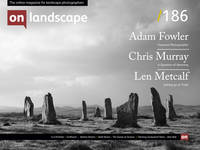A less well known location with an interesting history

Keith Beven
Keith Beven is Emeritus Professor of Hydrology at Lancaster University where he has worked for over 30 years. He has published many academic papers and books on the study and computer modelling of hydrological processes. Since the 1990s he has used mostly 120 film cameras, from 6x6 to 6x17, and more recently Fuji X cameras when travelling light. He has recently produced a second book of images of water called “Panta Rhei – Everything Flows” in support of the charity WaterAid that can be ordered from his website.
To clearly express my feeling for life with photographic beauty, present objectively the texture, rhythm, form in nature without subterfuge or evasion in technique or spirit, to record the quintessence of the object or element before my lens, rather than an interpretation, a superficial phase, or passing mood – this is my way in photography. It is not an easy way. ~ Edward Weston, 1927
There are a number of highly photogenic dune systems in the United States. The best known include Mesquite Flat Dunes in Death Valley National Park in California, the White Sands National Monument in New Mexico and the Great Sand Dunes National Park in Colorado; but there are also others that are somewhat less well known and less often visited such as the Oregon Sand Dunes National Recreation Area; the Algodones Dunes in the far south east of California; the Dumont Dunes in the Mojave Desert in east California; and (perhaps) the Oceano Dunes on the coast of California, situated between Santa Barbara and Monterey.
The Oceano Dunes are but one section of the Guadaloupe – Nipomo sequence that stretches for some 29 km along the coast from southern San Luis Opisbo County to the northern part of Santa Barbara County. It includes the highest coastal dune in on the west coast of the U.S., Mussel Rock Dune at 150m, just south of Oceano. The sequence includes the Pismo Dunes to the north and the Guadalupe-Nipomo Dunes National Wildlife Refuge and Rancho Guadalupe Dunes Preserve to the south. There are also areas where sand buggies and other All Terrain Vehicles can make a lot of noise, including the Oceano Dunes State Vehicular Recreational Area. The size of this permitted area has been reduced over the years but if you Google the Oceano Dunes you will find much more about riding the dunes than about photography.
However, I qualified the Oceano Dunes with perhaps less well-known because while they may not attract so many photographers today 1, the area has an interesting history and has been the subject of some classic photographs, most notably by Edward Weston, his son Brett Weston and Ansel Adams. Nancy Newhall in The Photographs of Edward Weston2 published by the Museum of Modern Art in 1946 wrote:
Considered by many to be Weston’s most accomplished series of images, the twenty-nine Dune photographs that resulted from his time at Oceano certainly show the artist at the peak of his creative powers. Weston first visited the area briefly in 1934 but returned two years later with his lover and muse, Charis Wilson, for an extended period of photography.
He found the undulating landscape perfectly suited to his interest in form and pattern and produced work that encapsulated many of the ideas he had been developing about the photographic image.
Much later, in 1948, Edward Weston was filmed at Oceano by Willard van Dyke as part of a film about him called The Photographer produced for the US Information Agency3. Van Dyke had studied as an assistant with Weston and was a founder member (with Edward Weston, Imogen Cunningham, Ansel Adams, John Paul Edwards, Sonya Noskowiak and Henry Swift) of the f64 group. He later gave up still photography in favour of film making. In a 1982 documentary, he said that this was so as not to compete with his good friend and past mentor Weston.

